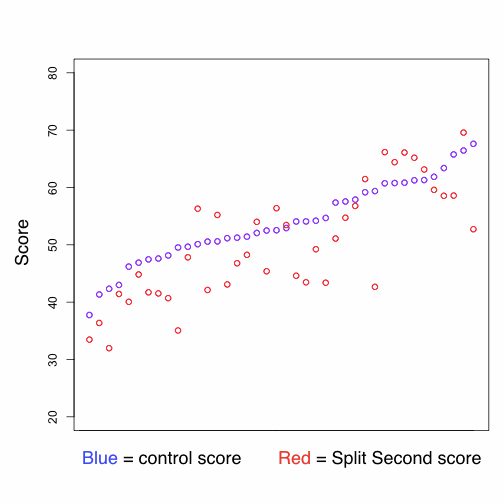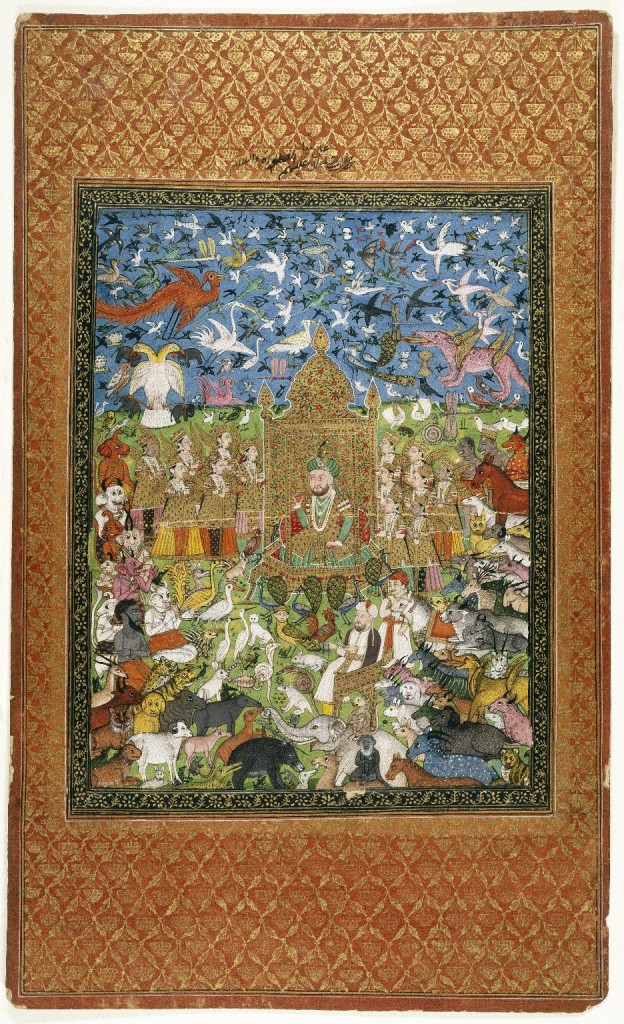Split Second Stats #1: Thin-slicing vs. unlimited time
A big inspiration for Split Second: Indian Paintings was the book Blink: The Power of Thinking Without Thinking by Malcolm Gladwell. Blink introduced the general public to the idea of “thin-slicing,” the notion that “decisions made very quickly can be every bit as good as decisions made cautiously and deliberately.” This idea has been widely studied and applied, in tasks as banal as deciding who to “friend” on Facebook, or as serious as recognizing potential terrorists at airports.
In this, the first in a series of posts about the Split Second experiment and our findings, I’m going to describe the first part of the experiment, and then say something about what some of the results might tell us about thin-slicing.

In the first part of the experiment, participants were presented with a series of pairs of Indian paintings, making snap decisions about which of each pair they liked best. We called this the “Split Second” task. Decisions made during the Split Second task were “thin” in two ways: First, each decision had a time limit of 4 seconds. Second, participants had no extra information about the painting, and had to “go from their gut.” The results from the Split Second task told us which paintings did better in thin-sliced conditions.
But looking at thin-slicing alone wasn’t quite enough for us. In order to really learn about how thin-slicing works, we needed to compare thin-sliced decisions to other kinds of decisions. To do this, we split off a number of participants into a “control group.” Rather than completing the second section of the experiment like the rest of the participants, the control group completed a neutral, unlimited time task with which we could compare all of the other tasks (like the Split Second task). The control group was presented with a series of individual paintings, with no additional information, and given unlimited time to rank each painting on a linear scale from “Meh…” to “Amazing!”
The result of each of these tasks came in the form of a ranking. The first ranking was based on thin-sliced decisions, and the second was based on decisions made with unlimited time. When we analyzed the two rankings, this is what we found:
- If a painting did well (or poorly) in the Split Second task, it probably did well (or poorly) in the control task, too. In science-speak: thin-sliced judgments were very strongly correlated with unlimited time judgments (cor = .8, p < .00000001). Good news for thin-slicing!

- However, when the time restriction was lifted, there were some huge rankings upsets! You can look at a comparison of the rankings on the Split Second exhibition page. Some objects saw big drops in ranking; e.g. Utka Nayika. More dramatically, we see King Solomon and His Court jump from somewhere near the middle of the pack all the way up to number one! This is an extremely dense, complex painting, which leads us to the next finding…

Indian. King Solomon and His Court, 1875-1900. Opaque watercolor and gold on paper, sheet: 19 11/16 x 11 7/8 in. (50.0 x 30.2 cm). Brooklyn Museum, Gift of James S. Hays, 59.205.16
- Visually complex paintings did pretty well in the Split Second task, but did extremely well in the control task. That is, paintings that had a lot of different stuff in them (patterns, many different colors, lots of changes throughout the painting, intricate detail) had higher ratings than other paintings in both tasks, but when time was unlimited, those paintings were ranked a lot higher. This suggests the 4-second time limit muted some of the positive effect complexity can have on judgment of a work. In science-speak, we found that complexity was correlated with ranking in both tasks, but that the correlation was much stronger in the control task (Split Second task: cor = .25, p = .001; control task: cor = .49, p = .001).
- Paintings whose central four colors were very different from each other did worse in the unlimited time task (cor = -.38, p = .013).
- Finally, we found that paintings with big frames did much more poorly in the Split Second task than in the control task. This might not sound like an impressive finding at first, but it’s quite strong: the negative hit paintings with large frames took in the Split Second task (cor = -.48, p < .000001) was just as big as the boost complex paintings got in the unlimited time task (cor = .49, p = .001). This suggests thin-sliced judgments were strongly biased against paintings with big frames.
These results paint a complicated picture of thin-slicing. I think one of the big issues with Gladwell’s Blink is that it doesn’t really give a good idea of when thin-slicing makes sense and when it doesn’t. Thin-slicing is clearly a powerful, effective tool, but it privileges certain qualities over others. Hopefully, by studying these qualities, we can help figure out in what circumstances thin-slicing works best, and when thicker slices might do a better job.
The results summarized above suggest thin-slicing privileges images which are vibrant and clear. On a computer monitor, a large frame means a smaller central image, and high complexity makes paintings harder to understand quickly—but it seems wrong to suggest that the complexity or frame style of King Solomon and His Court are flaws which should cause its ranking to drop. Indeed, when participants were able to take their time, it rose to the top of the list. This suggests that, despite its overall effectiveness, thin-slicing doesn’t reliably engage with complexity, and this can cause us to overlook some gems.

Beau Sievers is a composer and music cognition researcher. He has a blog. Growing up in the Bay Area, he's been bossing computers around (and vice versa) since the 3rd grade. He is currently working on his PhD at the University of Virginia.


jarak - 12 years ago
Thank you for sharing the stats gathered from this project!
The Paintings -> Ratings / Reactions pages are great. To be clear, is the rating an overall rating?
e.g. the King Solomon and His Court: “This painting was chosen 76% of the time over other paintings.”
One minor issue I have:
The rankings plot (especially the engagement one) is really kind of hard to read.
Overall, I’m really enjoying this. Although I liked the Click! exhibit, I feel like I’m actually learning more about Indian paintings through this. Plus I also felt like I needed to see these in person (lots of detail that you need to see in person) whereas I was satisfied to see the photos (Click!) online, even though I did see that exhibition in person as well.
Great discussion last night too!
Beau Sievers - 12 years ago
Hi Jarak: those percentage ratings refer to the Split Second (4 second time limit) task only, not to any of the other tasks.
Glad you enjoyed the discussion!